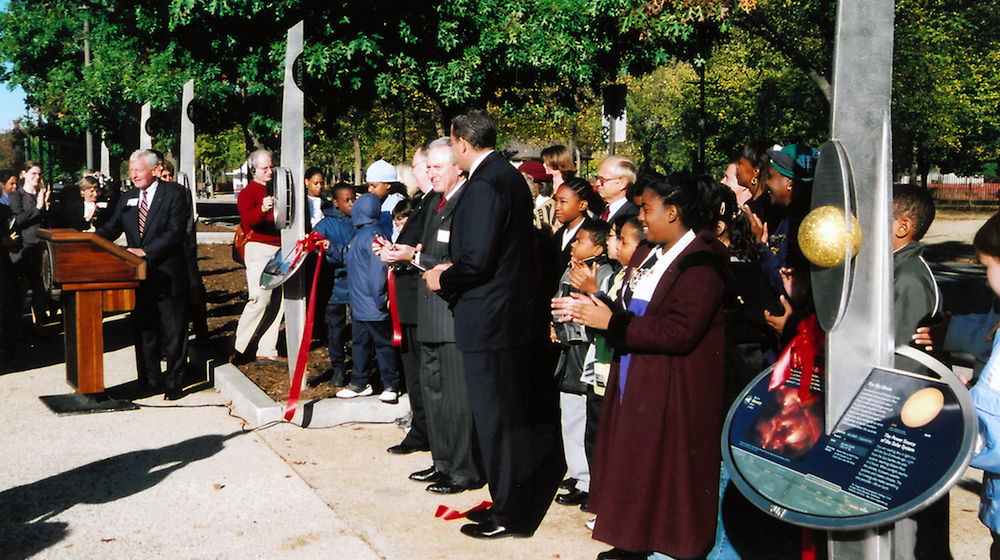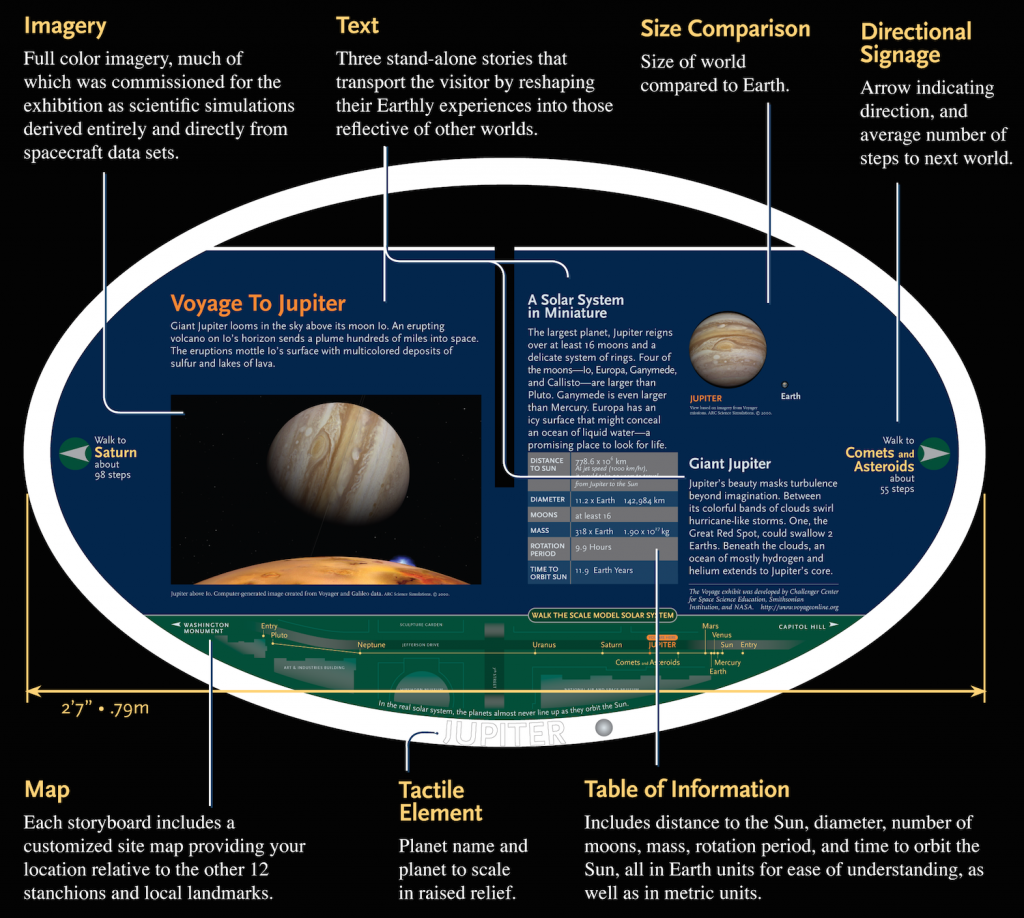NOTE: This is a sub-page of the Available Exhibitions page, which you should read first.
Last revised: September 25, 2020
Voyage Mark I Exhibition
The original Voyage scale model of the Solar System was permanently installed on the National Mall in Washington, DC, in October 2001. The initial intent of the Voyage National Program was to make replicas of Voyage on the National Mall available for permanent installation in communities across the U.S. and Canada. The replica is designated the Voyage Mark I exhibition. The single difference between Voyage on the National Mall and the Voyage Mark I, is that the stanchions of the former are made of solid stainless steel, and those of the latter are made of solid anodized aluminum. To date, the Voyage Mark I has been permanently installed in Houston, TX, Corpus Christi, TX, and Kansas City, MO. The Voyage Mark I is currently available for communities in the U.S. and Canada.
The design elements for the Voyage Mark I stanchions are provided in the graphic at right. For 360-degree views of the Sun and planet stanchions, watch the videos created by the National Capital Planning Commission as part of the approval process for Voyage placement on the National Mall. The videos are found on the Mark I Multimedia page.
1. Key Objectives
- provide exhibition visitors a conceptual understanding of Earth’s place in space, and the nature of worlds across our Solar System, through use of high precision models, text, imagery, and activities promoting inquiry-based exploration
- extend and enhance existing informal science and STEM education experiences to outdoor spaces
- foster a community engagement model for STEM education, with the means to engage: students in grades K-16; educators across grades K-12; families; and the general public
- foster experiences and programming that are strategic, addressing a community’s educational goals in STEM education; systemic, addressing the curriculum across local school districts; and sustainable, providing content and resources on an ongoing basis
- create a network of Voyage Communities, and foster inter-community exchange of ideas for educational programming
2. Appropriate Sites
Voyage is well suited for extended outdoor spaces (e.g., see image libraries for Voyage in Houston, and Voyage in Corpus Christi), parks, college campuses, and downtown walkways (e.g., see image library for Voyage in Kansas City).
Voyage –
- offers an added experience for family and general public visitors to a park or an extended outdoor space near, e.g., a museum or science center, and provides a greater context for an understanding of the natural world, planet Earth, and the sky above
- establishes a college or university as a local STEM education destination site
- provides an experiential thread along a downtown sidewalk, with opportunities for local businesses to leverage the experience with co-branded products and services
3. Baseline Mark I Exhibition Specifications, and Supplemental Educational Materials
- a model of the Solar System at one ten-billionth actual size, comprised of 13 stanchions spanning a reasonably linear 2,000 ft (600 meter) walking path; note that Voyage is only available at the 1 to 10-billion scale due to the embraced pedagogy for the visitorship experience – this scale cannot be modified to suit a specific site
- the diameters of the Sun, planets, and moons, and the distances between them, are all represented on the same 1 to 10-billion scale
- 13 anodized aluminum stanchions for: the Sun; 8 planets; Pluto; comets/asteroids; and two entry stanchions on opposite sides of the exhibition
- a gold anodized model Sun with surface texture
- 8 planets, the dwarf planet Pluto, and 15 moons laser-sculpted in 3 dimensions inside solid crystal block, with true oblateness, spin axial tilt, and visible cloud features on Jupiter, Saturn, and Neptune (read about Voyage’s accuracy). The Mark I exhibition includes the following moons: Earth’s Moon; Jupiter’s Io, Europa, Ganymede, and Callisto; Saturn’s Tethys, Dione, Rhea, and Titan; Uranus’ Ariel, Umbriel, Titania, and Oberon; Neptune’s Triton; and Pluto’s Charon.
- full color, high resolution porcelain enamel storyboards that provide imagery and compelling content, and include i) a Custom Site Map providing visitor location within the model Solar System relative to local way-finding landmarks, ii) the average number of steps to the adjacent stanchions (assuming the walking path is not curved), and iii) acknowledgment of local partners on the two entry stanchions. The design elements for the Voyage Mark I storyboards are provided in the graphic at right.
- raised hemispheres representing the 8 planets and dwarf planet Pluto at the 1 to 10-billion scale, located on the outer aluminum ring of the storyboards (see Jupiter Storyboard above), comprising the exhibition’s secondary Tactile Model Solar System for the vision impaired, as well as the general learner.
- a color master print file for a tour brochure – the Outdoor Exploration Guide – customized to the site, promoting self-guided, inquiry-based exploration of the Solar System. The Guide includes a description of the community, a Custom Site Map, and acknowledgment of local partners (see the customized Outdoor Exploration Guide for Voyage in Kansas City).
- a grade K-12 curriculum package, with lessons supporting pre-and post-visit activities, and relevant to curricular strands addressing Solar System content and exploration
- potential for supplemental programming, including: professional development for teachers, family and public programs, and researcher visits to classrooms across a community
4. Costs
- baseline cost for Mark I exhibition: $180,000, which includes exhibition fabrication; step-by-step procedures that address, e.g., identifying a viable site for the exhibition in your community, how to determine precise stanchion locations, and installation instructions; ongoing support from initial interest through installation; access to the grade K-12 curriculum package of lessons; and a color master for the Outdoor Exploration Guide
- shipping: shipping to the community is a separate cost borne by the community
- installation: stanchions are bolted to poured concrete footings; installation is a separate cost borne by the community
- insurance: if the community feels insurance coverage of the exhibition is warranted, it is a separate cost borne by the community
- supplemental programming: supplemental programming is available through Journey through the Universe, another initiative of the National Center for Earth and Space Science Education, but is an added cost to the community. Journey through the Universe can provide some combination of: i) public and family programs as an exhibition opening event; ii) a national team of Earth and space science researchers visiting the community for a few days, and visiting potentially thousands of students one classrooms at a time; and iii) professional development for teachers on the Voyage grade K-12 curriculum package
Voyage Mark I exhibition production is done as a ‘one-off’ – fabricated one exhibition at a time.
5. Fundraising Assistance
The National Center for Earth and Space Science Education cannot provide any fundraising assistance for a Mark I exhibition.
Note: the Center will provide significant fundraising assistance, on a case-by-case basis, for a Mark II exhibition.
6. Requirements
- site: reasonably linear 2,000 ft (600 meter) walking path
- Implementation Plan: submission of an Implementation Plan by a community’s lead institution demonstrating how the exhibition and educational materials would be put to work to address the Key Objectives listed above
- site availability: a Letter of Site Authorization is required, which is signed by the institution with both legal authority over the site, and authority to approve permanent installation of the exhibition on the site
7. How to Explore a Voyage Mark I Exhibition for Your Community
For more information on the Voyage Mark I design, community requirements, installation, cost, and how to apply to become a Voyage Community, contact Dr. Jeff Goldstein, Voyage National Program Director, and Center Director, National Center for Earth and Space Science Education, 301-395-0770, jeffgoldstein@ncesse.org




